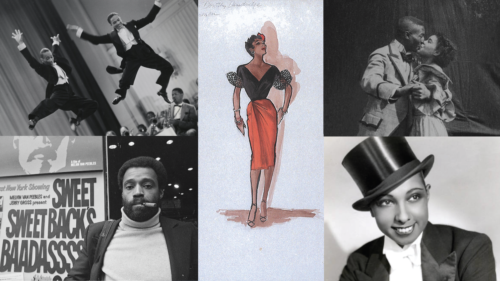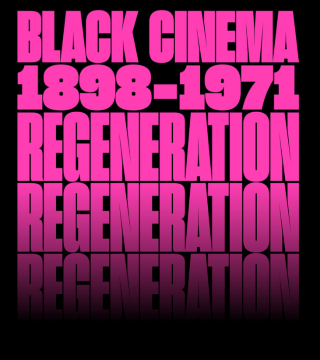ACADEMY MUSEUM OF MOTION PICTURES OPENS
REGENERATION: BLACK CINEMA 1898–1971 ON AUGUST 21, 2022
Offering the public a chance to learn more about how Black performers and filmmakers have helped define cinema in the United States, the exhibition explores the achievements and challenges of both independent production and the studio system, from cinema’s infancy in the 1890s through the height of the civil rights movement. Regeneration features rarely seen excerpts of films restored by the Academy Film Archive, as well as other narrative films and documentaries; newsreels and home movies; photographs; scripts; drawings; costumes; equipment; posters; and historical materials, such as entrance tickets, note cards, and telegrams; along with augmented reality experiences (AR) designed specifically for the exhibition. The second major temporary exhibition to be organized by the Academy Museum, Regeneration will remain on view through April 9, 2023.Regeneration comprises seven galleries dedicated to: exploring the social and political situation of Black Americans at the dawn of cinema in the United States; the representation of Black people in early cinema from 1897 to 1915; pioneering independent Black filmmakers such as Oscar Micheaux and “race films,” made for Black audiences from the 1910s to the 1940s; Black music in American film, including “soundies” and Black musicals; Black stars and film icons; cinematic stories reflecting the freedom movements; and the daring and pioneering paths Black film directors blazed during the civil rights movement. Highlighted objects on view include never-before-shown costume drawings from Carmen Jones (1954); promotional glamour portraits of dozens of leading Black film stars; costumes worn by Lena Horne in Stormy Weather (1943), and Sammy Davis, Jr. in Porgy and Bess (1959); cowboy boots worn by Herb Jeffries in Harlem on the Prairie (1937); a 1920s camera from the Norman Film Company, a producer of race films; a Mills Panoram machine from the 1940s; tap dance shoes from the Nicholas Brothers; and one of Louis Armstrong’s trumpets.
The exhibition opens with two versions of a clip from Something Good – Negro Kiss (1898), showcasing vaudeville performers Saint Suttle (1870–1932) and Gertie Brown (1882–1934) in what appears to be one of the earliest examples of on-screen affection by Black actors. Unknown prior to 2016, when it was discovered in the United States, another version of the clip was recently found in Norway and will also be presented. This silent work counters the popular stereotypical and racist caricatures of Black performance at the time.The next gallery highlights “race films,” which were independently made productions with all-Black casts created between 1916 and the 1940s. These films often offered more nuanced stories and roles for Black actors than mainstream studio productions. A wall featuring vibrant movie posters demonstrates the scale and range of genres of these films, and spotlights companies and filmmakers in different geographic regions of the US. This section is amplified by materials on segregated movie theaters, alongside an interactive US map highlighting the volume of race film productions, and a curated selection of existing race film clips shown in a specially designed in-gallery theater.The exhibition goes on to explore the opportunities and complexities that arose when Hollywood began to include more depictions of Black actors, specifically in films featuring music, as demonstrated by early sound films “soundies”—the three-minute precursor to the music video—and Hollywood’s all-Black-cast musicals. This gallery also looks beyond the United States and highlights the career of Josephine Baker in France.The “Stars and Icons” gallery recognizes numerous Black performers in Hollywood from the 1920s through the late 1950s, many of whom achieved mainstream notoriety, although a significant number did not. A large-scale installation of more than fifty glamour photographs features top-billed stars and previously uncredited artists as a way of showcasing their lasting influence on American cinema. This installation is in dialogue with home movies that feature private images of stars like the Nicholas Brothers, Cab Calloway, and Josephine Baker. A large-scale film montage features striking musical numbers with Black performers together with some never-seen-before costumes. A spotlight on Hattie McDaniel’s Oscar win and complicated fame is also presented in this gallery.The exhibition culminates with a section devoted to freedom movements, demonstrating how advances in the Black freedom struggle impacted the film industry. A section on World War II showing propaganda films and newsreels offers insight into that critical era of the civil rights movement. A parallel projection highlights clips from documentaries and feature films side-by-side, demonstrating the relationship between films and the sociopolitical struggles of the era. An assortment of photographs, drawings, posters, and magazines highlights how actors such as Harry Belafonte, Ruby Dee, Ossie Davis, Sidney Poitier, and Paul Robeson. As well as writers Lorraine Hansberry and James Baldwin, who used their platforms to fight for social and racial justice.Regeneration’s final gallery pays tribute to five Black directors active from the 1960s onward—Madeline Anderson, Robert L. Goodwin, William Greaves, Gordon Parks, and Melvin Van Peebles—and shows how their unique perspectives allowed them to create documentaries, independent films, and Hollywood productions that have helped pave the way for current and future filmmakers of color.Throughout the exhibition, to address the continuing impact of the legacy of Black filmmaking and its interplay with other traditions in visual art, the exhibition also includes works by contemporary artists including Theaster Gates (Some Remember Sock Hops, Others Remember Riots, 2020), Glenn Ligon (Double America 2, 2014), Gary Simmons (Balcony Seating Only, 2017), Kara Walker (The End of Uncle Tom and the Grand Allegorical Tableau of Eva in Heaven, 1995), and Carrie Mae Weems (Slow Fade to Black II, 2010).Regeneration received the 2018 Sotheby’s Prize for curatorial excellence and for facilitating an exhibition that explores overlooked or underrepresented areas of art history.
